Ineichen’s second auction of the year took place on April 23, 2022 and was aptly called Precious Blues as it featured a curated selection of 50 rather rare timepieces with blue details.
This was a white glove sale, meaning all 50 lots were sold. And, pretty astonishingly, they all sold at or above their high estimates. Impressive!
The auction’s top performer wouldn’t have been that hard to guess: it was lot 40, a Tiffany co-signed Patek Philippe Reference 5712/1A-001 Nautilus with small seconds, power reserve, and moon phase, which sold for CHF 290,000 (all prices mentioned here excluding buyer’s premium).
The next two highest performers did not come from mainstream brands, however, which I found very exciting: the Richard Mille RM30 in blue hammered for CHF 230,000 and Greubel Forsey’s Tourbillon 24 Secondes Contemporain found a new home for CHF 180,000.
The eight timepieces in the auction that I paid special attention to in a previous article, some really cool under-the-radar rarities, went above and beyond their high estimates. Here are their results.
Result: lot 9, Breguet Type XX Transatlantique
The only Breguet timepiece in this auction was a 39 x 14.4 mm white gold Type XX made between 2000 and 2012 with a pretty rare and absolutely gorgeous blue dial whose looks I found striking for a historically inspired watch.
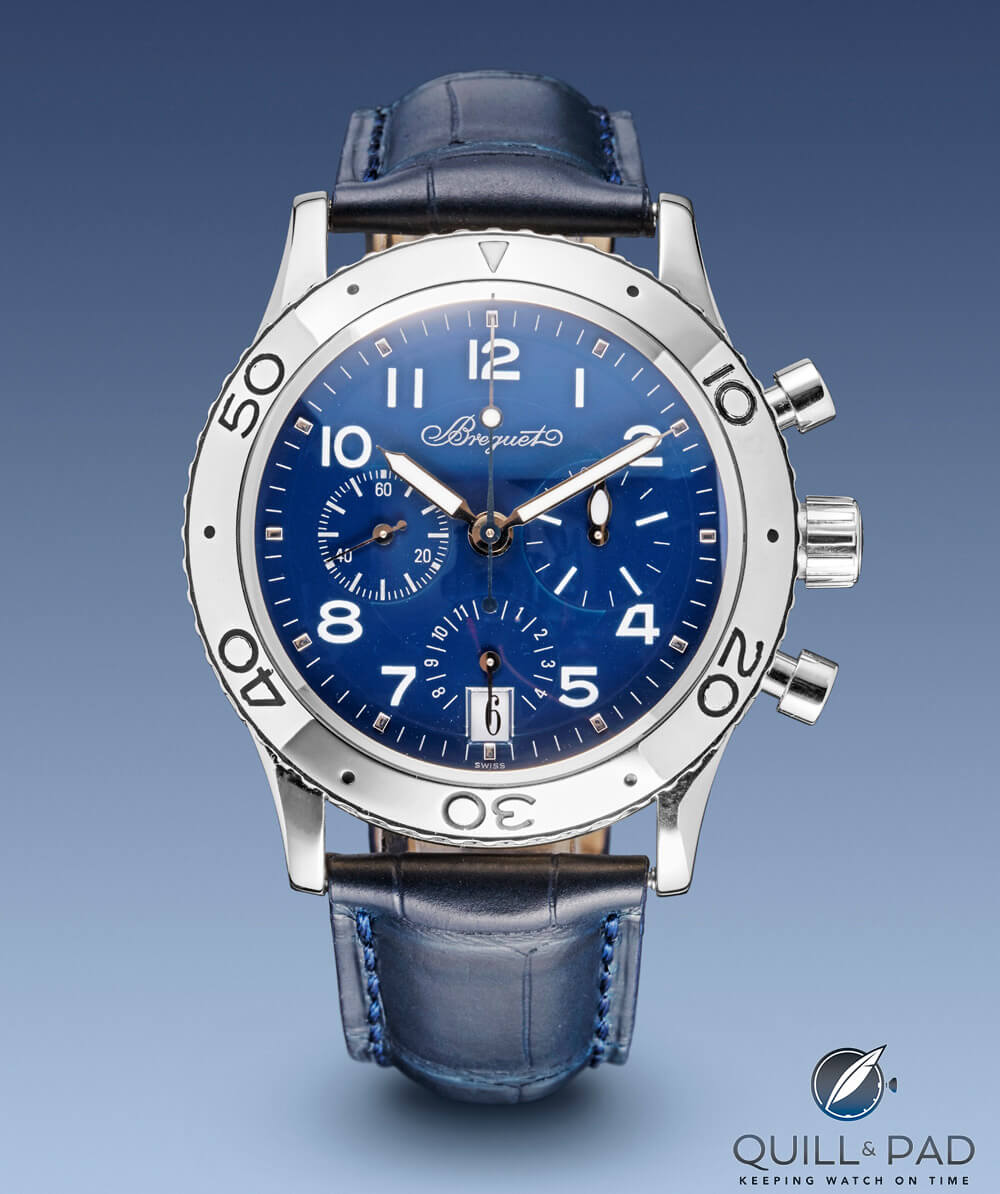
Breguet Type XX Transatlantique (lot 9) from Ineichen’s Precious Blues auction
The estimate on the Breguet Type XX Transatlantique was CHF 5,000 to 7,000, and it hammered for CHF 12,000.
Learn more about Type 20 (and Type XX) watches in Complete Guide To Type 20 Pilot’s Watch Chronographs.
Result: lot 19, H. Moser x MB&F Endeavour Cylindrical Tourbillon
This collaborative Endeavour Cylindrical Tourbillon launched in mid-2020 as one of the first serious timepieces to come out during the pandemic. It was certainly a risk for H. Moser & Cie and MB&F to introduce it at that time, but the risk paid off and it sold out (and through) immediately. Both it and its sister timepiece, the MB&F x H. Moser LM101.
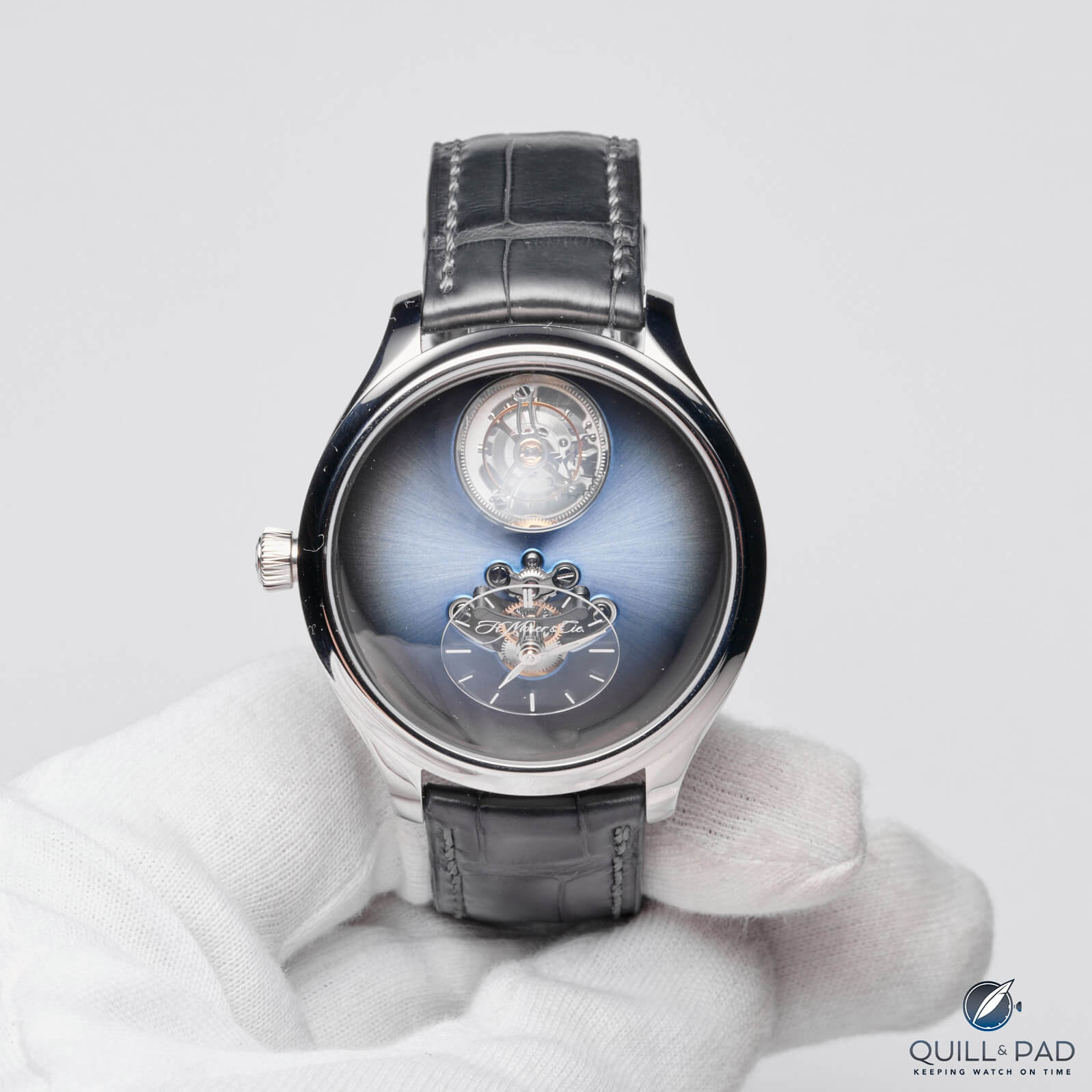
H. Moser x MB&F Endeavour Cylindrical Tourbillon (lot 19) from Ineichen’s Precious Blues auction
The Endeavour Cylindrical Tourbillon was offered in five limited editions of 15 examples each in steel with dials in Ice Blue, Funky Blue, Burgundy, Cosmic Green, and Off-White Fumé, the latter with blued hour and minute hands. This Ice Blue version was sold by Moser exclusively online.
As one of only 15 pieces of this model with an Ice Blue dial, I’d say this is pretty rare. And at a retail price of $79,000, should the estimate stay within its predicted range of CHF 50,000-60,000, it would have become a rather good deal considering current prices for pre-owned MB&F and Moser timepieces. Its final price did exceed that high estimate, coming in at CHF 70,000.
For a full rundown of this model at the time of its launch, including hands-on photography, please see Hands On & Live Photos: MB&F x H. Moser LM101 And H. Moser x MB&F Endeavour Cylindrical Tourbillon.
Result: lot 22, De Bethune DB28 Kind of Blue
I cannot hide my love for De Bethune. If you read this publication often, you will know that I openly profess it every time I can. Which made it very, very hard to pick just two watches from the nine in this auction. I chose to write about the DB28 Kind of Blue and the DB28 Digital (below); the other seven were: DB24 (lot 13), DB28 GS (lot 20), DB25 Starry Sky (lot 27), DB25 Moon Phase (lot 30), DBS-W (lot 36), DB25 Moon Phase (lot 41), and DB26 Perpetual Calendar.
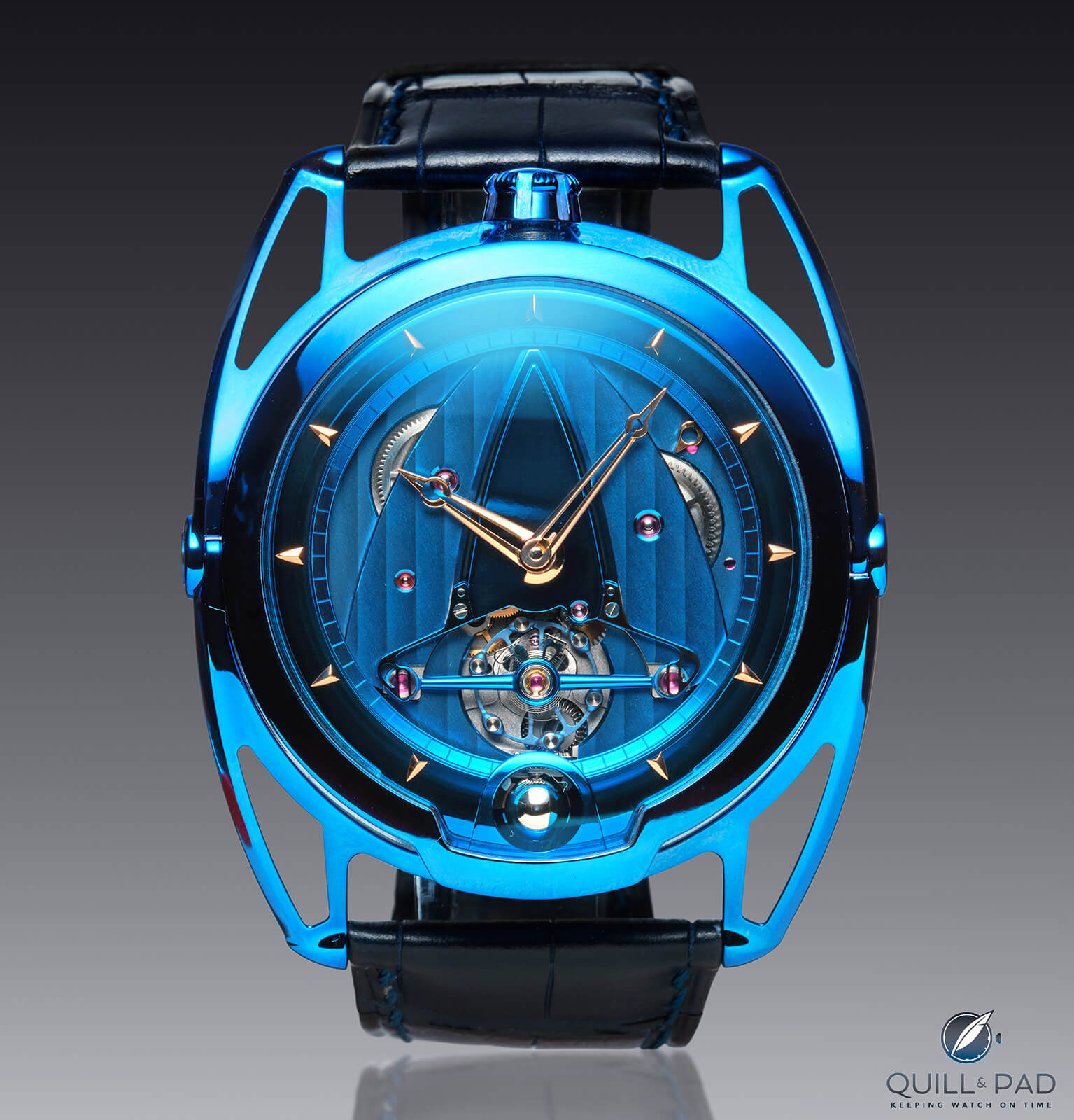
De Bethune DB28 Kind of Blue (lot 22) at Ineichen’s Precious Blues auction
The De Bethune DB28 Kind of Blue is definitely among my favorites (as if I could ever pick a favorite!). I love the beautiful blued titanium elements of this brand – the most beautiful blue in the business in my opinion – and the three-dimensional moon phase in conjunction with the movement visible from the front. These elements together are such a winning combination, I could look at them all day, every day. In fact, I did just that the time I was lent the DB28 Kind of Blue Tourbillon for a week – a week in heaven!
The Kind of Blue series is limited to just five pieces produced per year, and the example here was manufactured in 2021. De Bethune reports only 17 pieces made since 2016. It was offered in nearly unworn condition at an estimate of CHF 70,000-90,000 and hammered for CHF 130,000.
Result: lot 31, De Bethune DB28 Digitale
But perhaps – just perhaps – my very favorite De Bethune is the DB28 Digitale introduced in 2014. Here the hours are displayed in jump fashion, while the minutes are on a ball bearing-mounted disk that moves in retrograde motion.
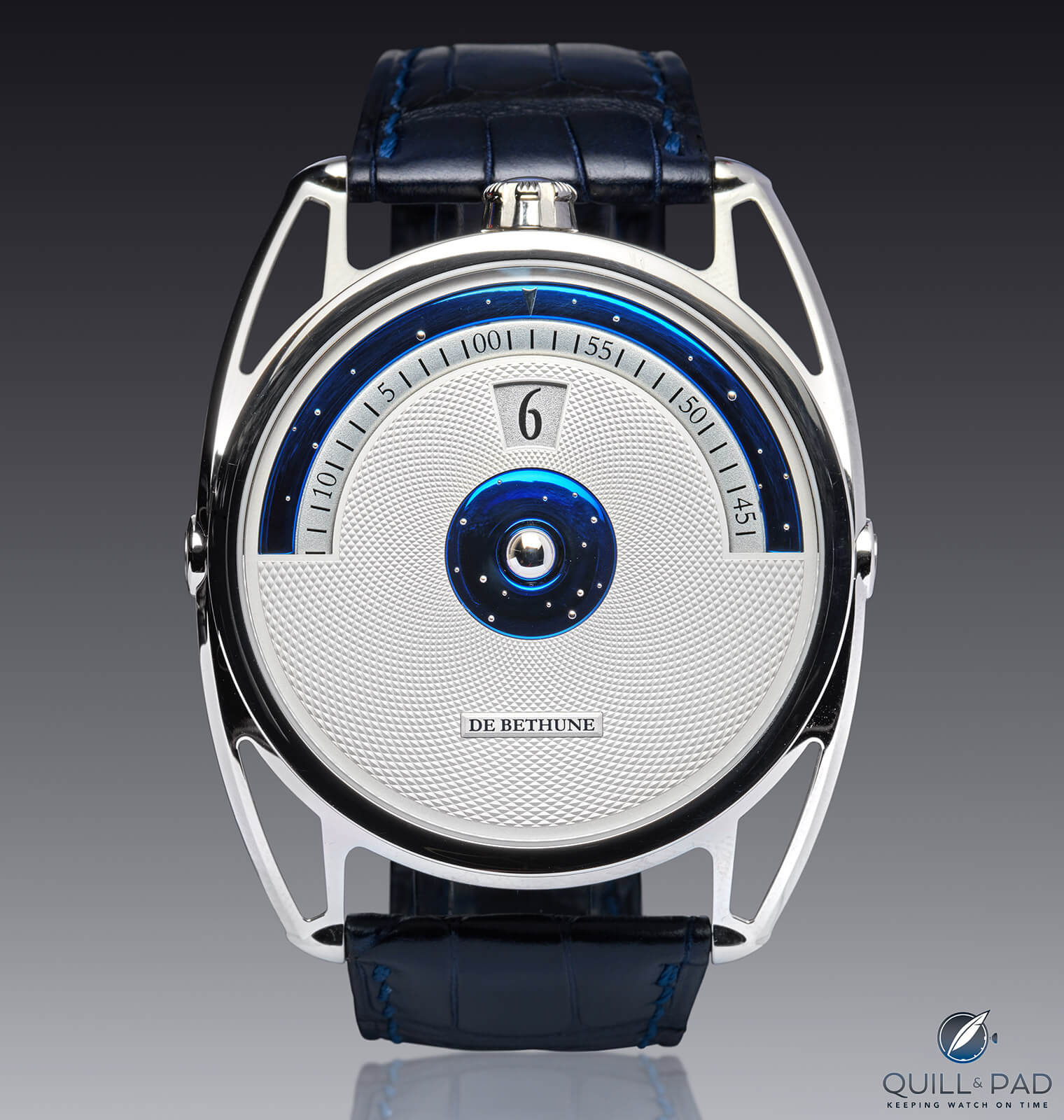
Lot 31 at Ineichen’s Precious Blues auction: De Bethune DB28 Digitale
And then there is that three-dimensional moon phase right in the center of the dial, two-thirds of which is a beautiful hand-guilloché barleycorn radiating out from a polished and heat-blued titanium central disk studded with white gold “stars.”
De Bethune reports only 32 pieces of the Digitale made since 2014. This piece crafted in 2021 is being offered in the auction at an estimate of CHF 60,000-80,000, and it sold for CHF 95,000.
See more about this watch in The Nine Muses And The De Bethune DB28 Digitale.
Result: lot 37, Andersen Genève World Time 1884
In 2003, A.H.C.I. co-founder Svend Andersen introduced a timepiece in homage to the standardized world time created by Sir Sandford Fleming in 1884. Appropriately, Andersen named his masterpiece 1884, dedicating the gold rotor to Fleming and including his name, years of birth and death, bust, and the words “inventor of world time.” The 40 mm watch was offered in a series of 50 pieces in pink/red gold, 50 in white gold, and 20 in platinum.

Lot 37 at Ineichen’s Precious Blues auction: Andersen Genève World Time 1884
Lot 37 is one of those pieces: in fact, it’s number 99 of the total of 120 pieces.
This white gold watch is a piece of history. And according to Ineichen, it’s in practically mint condition.
It exceeded the auction house’s estimate of CHF 6,000-8,000, coming in at CHF CHF 10,000.
Result: lot 43, A. Lange & Söhne Grand Arkade
This watch rarely ever comes up at auction: the A. Lange & Söhne Arkade was one of the four original timepieces issued by the Saxon brand in 1994 at its rebirth. Walter Lange imagined the Arkade as the brand’s “ladies’ timepiece,” but gendering watches was a practice discarded at A. Lange & Söhne early on, the brand preferring instead to use adjectives like “Grand” for the larger versions and “Little” for the smaller versions of watches that deviated from their classic sizes.

Lot 43 at Ineichen’s Precious Blues auction: A. Lange & Söhne Grand Arkade
The lot here is the Grand Arkade, which was launched in 2002, and not the classic size, which I recall having been discontinued before then. The Grand Arkade was discontinued in 2005.
Aside from the size – a robust 38 x 29.5 x 9 mm – the Grand Arkade includes other stylistic changes over the smaller Arkade such as the greater number of Arabic numerals over hour markers and a larger subsidiary seconds dial with a triangle-tipped hand.
The Arkade is rarely seen on the second-hand market. And within the small amount of Arkade models in circulation, the white gold versions with their beautiful deep blue galvanized solid silver dials are even rarer.
This watch was a real deal at the auction house’s estimate of CHF 6,000-8,000, and was certainly treasured by its new owner, who procured it for CHF 17,500.
Result:lot 49, Alain Silberstein Tourbillon Volant Blue PVD Limited Edition
It makes me so happy to see this watch again! One of Alain Silberstein’s crazy tourbillons from 2003 from one of his craziest ideas: a limited edition of sixteen different tourbillons, each one funkier than the next and limited to 500 pieces – at that time an incredible number of tourbillons to be making. They were powered by the now-defunct Progress tourbillon caliber (which later became STT and was finally taken over by Bovet to become Dimier in 2006).
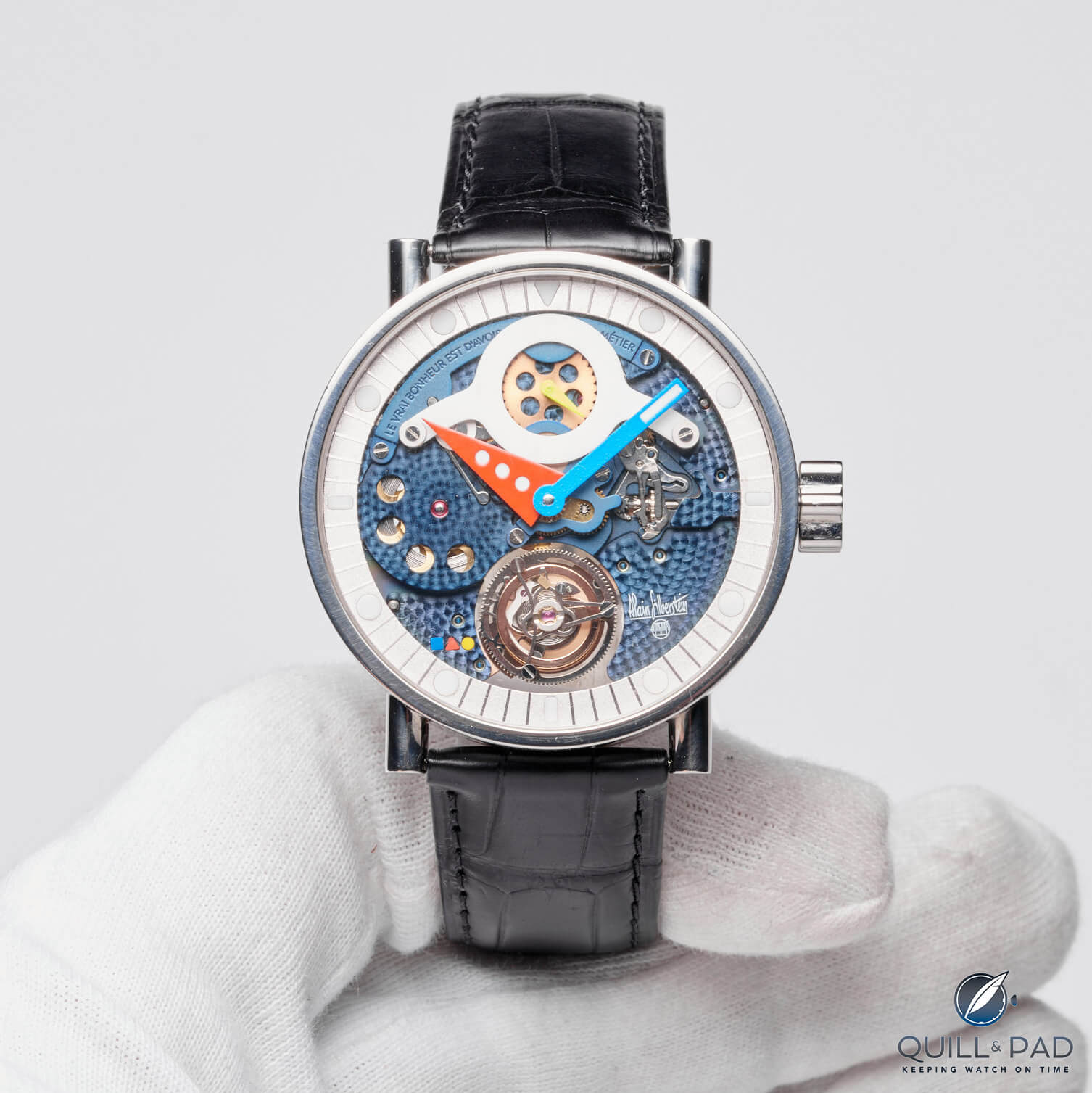
Lot 49 at Ineichen’s Precious Blues auction: Alain Silberstein Tourbillon Volant Blue PVD Limited Edition
I have no first-hand knowledge as to whether the editions were produced to the end, but Ineichen notes that there may not be any examples numbered over 100. Both Ineichen and Phillips do not believe that the production run was completed.
“Kinetic art” is what Silberstein called this marriage of color and technology. Remember that at that time tourbillons were still serious business; clothed in anything other than a traditional look they were bound to generate comment and criticism. This piece is representative of a cutting-edge moment in Silberstein’s career.
The Alain Silberstein Tourbillon Volant Blue PVD Limited Edition is a piece of modern watch history for sure. Its estimate was CHF 15,000-20,000 and it sold for CHF 29,000.
Result: lots 3, 4, 17, and 18, Ulysse Nardin Freak
The Ulysse Nardin Freak, however, is objectively an even bigger piece of watch history.
There are very few timepieces that have changed the course of watch history, but Ulysse Nardin’s Freak is one of them. I think that the truly modern era of watchmaking began in 2000 with the introduction of the first Freak with its Dual Direct Escapement. The shape of the escape wheels in the Dual Direct Escapement that made up the minute hand, and the fact that there were two of them, made it necessary for them to be lighter, more efficient, harder, more elastic, more resistant to wear, and above all friction-free so that they did not require lubrication.
Ulysse Nardin’s ensuing exploration of the LIGA process to make these escape wheels put the company’s extensive research into real motion. Supplier Mimotec not only enabled the brand to create perfectly smooth, friction-free parts in nickel and nickel-phosphorus alloys that were ideal for prototyping, but also joined Ulysse Nardin in the quest for further research into silicon.
Ulysse Nardin had originally partnered with CSEM (Centre Suisse d’Electronique et de Microtechnique S.A) for its work with silicon in a group that at the time comprised Swatch Group, Rolex, Patek Philippe, Richemont, and the Federation of the Swiss Watch Industry (FH).
In 2006, Mimotec and Ulysse Nardin entered into a joint venture to explore the combination of LIGA and silicon, christening the new firm created from the partnership Sigatec.
The Freak broke major conventions in traditional watchmaking, and the brand continued to introduce new versions of it that acted as little wrist laboratories. And was the first to do so.
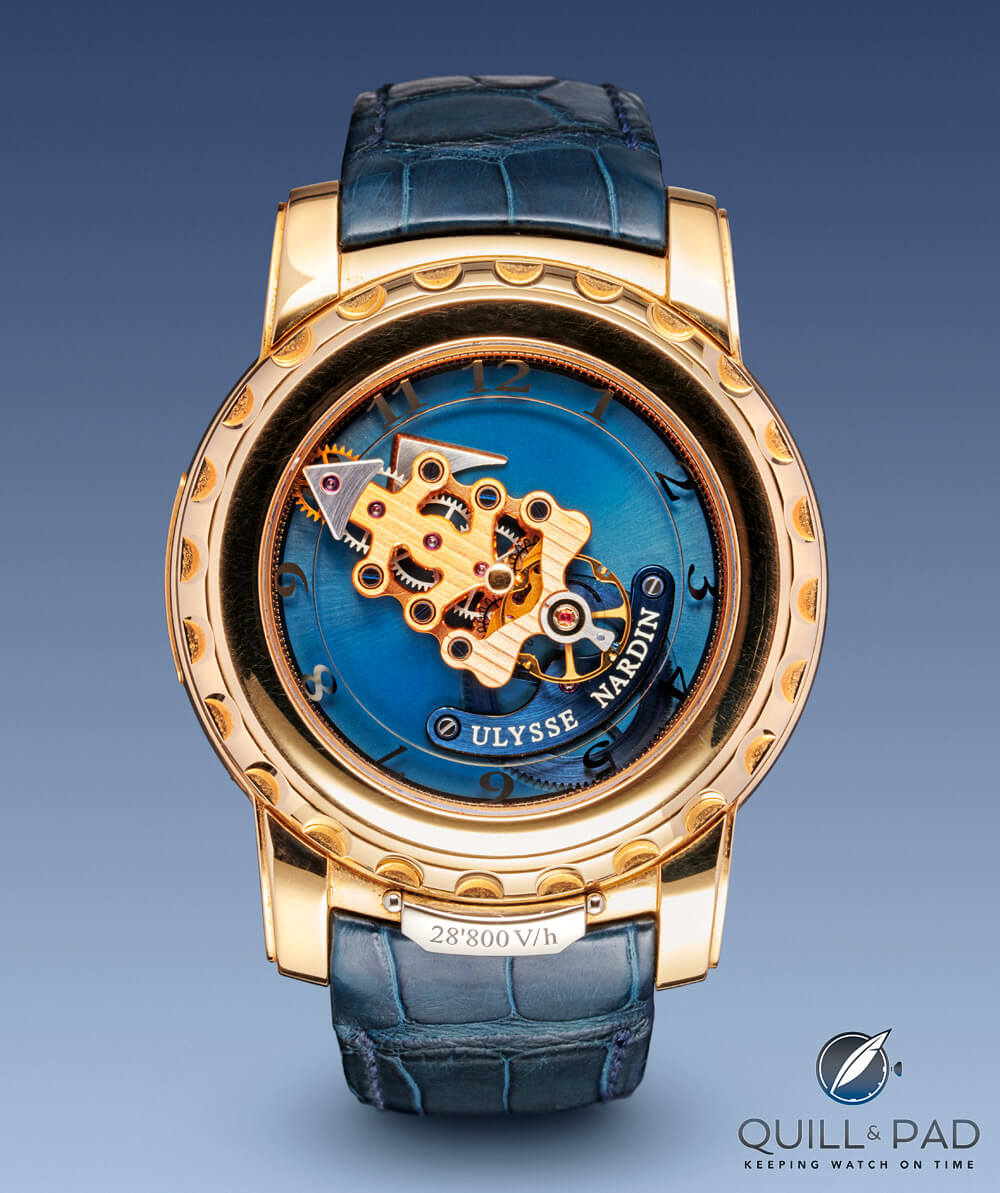
Lot 3 at Ineichen’s Precious Blues auction: second-generation Ulysse Nardin Freak in pink gold
Ineichen offered several versions of the Freak in this twenty-second year after its introduction (and perhaps not coincidentally the same year that Ulysse Nardin has chosen to head back to something closer to its own roots). Lots 3 and 4 are both variations of the second iteration of the Freak (Reference 026-88) launched in 2005 with a new version of the bezel and a bezel-locking mechanism to make moving the “hands” inadvertently less possible. Both versions (lot 3 in pink gold and lot 4 in white gold) carried estimates of CHF 15,000-20,000 and sold for CHF 23,000 and CHF 24,000 respectively.
Lot 17 is a white gold Freak Blue Phantom, which launched in 2008, though this example is from 2011. It was the last to be produced with the original caliber architecture conceived by Ludwig Oechslin. It carried an estimate of CHF 20,000-25,000 and sold for CHF 25,000.
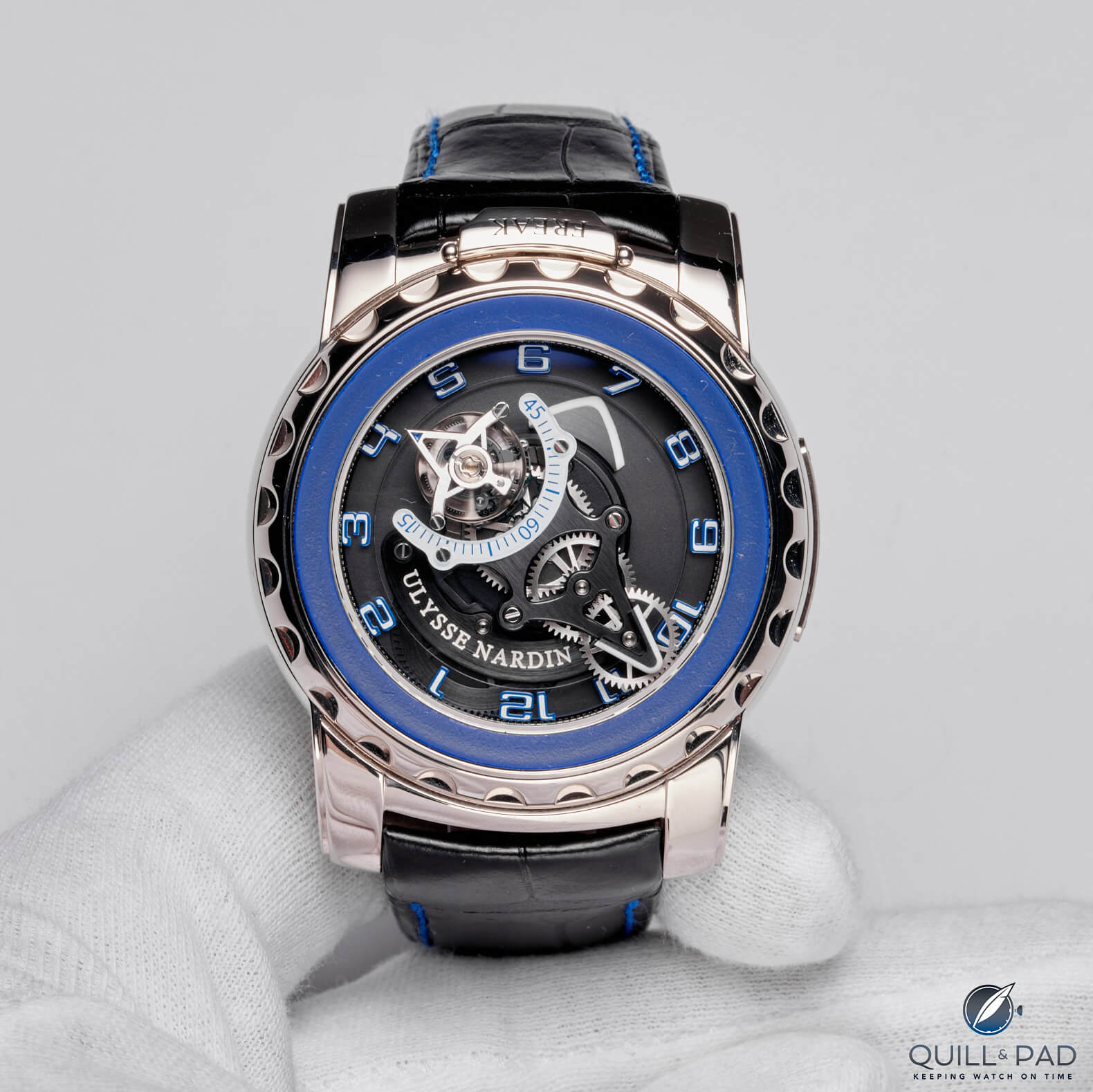
Lot 18 at Ineichen’s Precious Blues auction: Ulysse Nardin Freak Diavolo Tourbillon Blue
Which brings us to lot 18, the Freak Diavolo Tourbillon Blue Reference 2080-115/02, the first of the new version of the Freak called the Diavolo with a 60-second flying tourbillon replacing the dual escape wheels of the original concept. This new caliber was developed in 2010, debuting in the Freak Diavolo Rolf 75 in celebration of previous owner Rolf Schnyder’s seventy-fifth birthday. This particular example came after that and was manufactured in 2014. It was offered at an estimate of CHF 25,000-30,000 and sold for CHF 39,000.
Together, these examples of the Ulysse Nardin Freak presented a great overview of the evolution of this watch up until Ulysse Nardin’s takeover by Kering in 2014 after Schnyder’s death, when the watch completely changed character. Now, with Kering having sold the brand to its management team, I am seeing a return to some of the root ideas. But that’s a story for another day.
For more on this auction, please visit ineichen.com.
You may also enjoy:
Stainless Steel Patek Philippe Nautilus Market Madness: Thoughts On The Current Market Situation
Ineichen Auction ‘La Vie en Rose’ On March 12, 2022: 6 Unusual Picks From 40 Pink Gold Timepieces
Chess Moves: What The January 2022 Sale Of Ulysse Nardin And Girard-Perregaux Have To Do With Brioni
My First Auction Purchase: Alain Silberstein Pendant Watch
De Bethune DB28: How I Launched It, Why I Bought It, And Why It’s The Perfect ‘One Watch’





















































Leave a Reply
Want to join the discussion?Feel free to contribute!